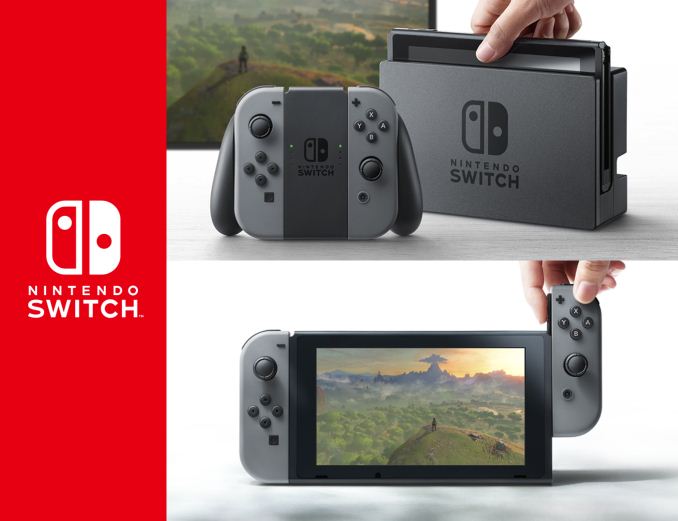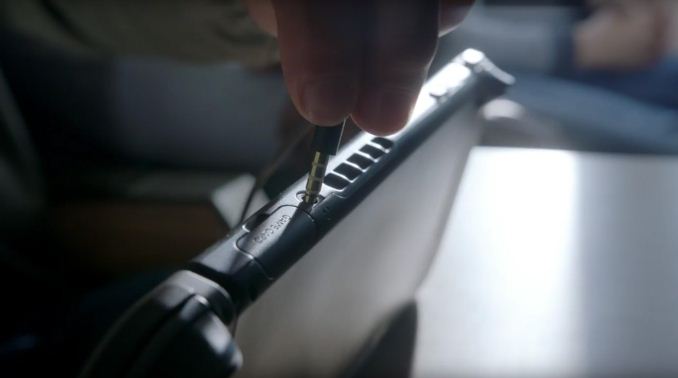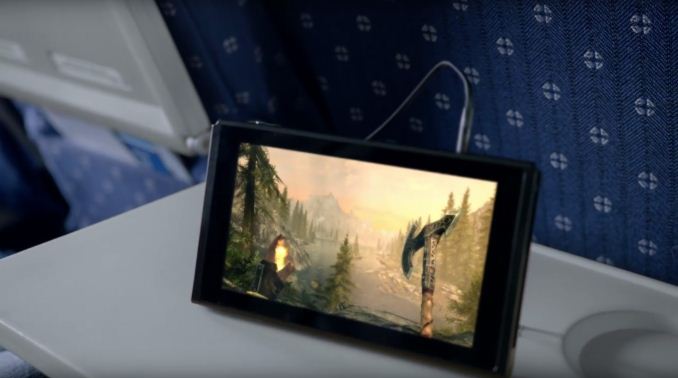Nintendo Announces Switch Portable Gaming Console - Powered by NVIDIA Tegra
by Ryan Smith on October 20, 2016 4:25 PM EST
Earlier today Nintendo took the wraps off of their next generation console, Switch. Formerly known by the codename NX, the Switch is the successor to both Nintendo’s portable DS and set top Wii console lines, utilizing a portable, tablet-like unit that can be docked to behave like a set top console. Today’s announcement, in the form of a 3 minute trailer, is meant to tease the console ahead of its full launch in March of 2017.
While I’ll skip the commentary on the console’s unusual design – dedicated gaming sites can offer better context – I wanted to dive into the hardware in the Switch. Given that this was a teaser, I was not expecting a reveal of any of the hardware specifications of the console, and indeed neither Nintendo’s teaser video nor their related press release made any mention of the underlying hardware. However shortly after the reveal went live, NVIDIA sent out an email to the press and posted a blog of their own. As it turns out, while today is still just a teaser, in some ways we’re already getting more information about the console than in any previous generation of Nintendo’s hardware.
In their blog post, NVIDIA confirmed that they would be providing the underlying SoC for the console. As this is still ultimately a teaser, NVIDIA’s own details are light, but their announcement confirms that it’s a custom version of their Tegra SoC. Curiously, no mention of the CPU core in that SoC is mentioned. However as it’s a Tegra, something ARM-based is the logical (if not only) choice. And on the GPU side, as you’d expect, they’re using a GPU based on one of NVIDIA’s existing GPU architectures, though the company isn’t specifying if it’s Pascal or Maxwell (I’d assume Pascal, but consoles are known for their long development cycles).
Otherwise, as far as specifications go that’s all we get for now. Though as NVIDIA is supplying a whole SoC there are obviously many more parts to the package that we’ll hopefully learn about in the near future. More CPU and GPU details are obviously the most interesting aspect – does the Switch SoC use Denver CPU cores? – but there’s also the matter of memory bandwidth, WiFi support, and the many other functional blocks that make up an SoC.
For NVIDIA, this is the first console hardware win for the company since the PlayStation 3, which launched in 2006. In the set top console market, AMD has since provided the GPU (and often, the CPU) for the most recent generation of consoles. Otherwise NVIDIA has never had a 3rd party portable console win, primarily because both Nintendo and Sony developed their respective SoCs internally for the 3DS and Vita.
In fact, given that Nintendo previously did much of their portable console development work internally, this is a notable shift for how the company operates. The 3DS was essentially a custom SoC combining multiple ARM11 (ARMv6) CPU cores with an OpenGL ES 1.1 generation GPU from the little-known Digital Media Professionals (DMP). So this is the first time Nintendo has contracted out their SoC needs to a third party in such a visible fashion. I’m actually a bit surprised that NVIDIA is even allowed to talk about their involvement at this point in time, given Nintendo’s historical focus on secrecy.
Though all of this also helps to underline just how big a jump in technology the Switch is from the 3DS. On the CPU side alone it’s reasonable to assume we’re looking at CPU design in the neighborhood of 4.x DMIPS/MHz, versus ARM11’s approximate 1.3 DIMPS/MHz rate, so IPC will have increased significantly, never mind an increase in frequency. Meanwhile on the GPU side, Nintendo is going from a GPU that didn’t even have a programmable GPU pipeline (i.e. shaders) to a fully modern GPU, essentially catching up on a decade of mobile GPU development in a single bound. Given that the console has to work as both the company’s portable and set top consoles, Nintendo has opted to use far more modern tech than their traditionally conservative designs.
Finally, without reading too much into a 5 paragraph announcement, there is one other interesting nugget of information in NVIDIA’s blog post that further shows just how deep the NVIDIA/Nintendo relationship is going here. Along with providing the SoC, NVIDIA also has a major stake in the development of the console’s API and middleware. While NVIDIA presumably isn’t developing the entire software stack, they make special note of the fact that they are providing a new “lightweight” API, NVN, for the console. NVIDIA is also providing middleware in the form of “a revamped physics engine, new libraries, advanced game tools and libraries” and “custom software for audio effects and rendering” which sounds a great deal like NVIDIA having brought over major parts of their GameWorks SDK, including the PhysX physics simulation libraries and VRWorks Audio library.
In any case, it will be interesting to see how this plays out over the next few months. The mobile world has changed significantly since the 3DS was launched in 2011, something that the Switch’s design makes obvious. Nintendo has gone in a very different direction than either their console rivals or the smartphone market that is always threatening to encroach on mobile consoles, and that’s reflected in both the unusual dual-mode console and the hardware inside of it.












109 Comments
View All Comments
LukeTim - Friday, October 21, 2016 - link
Laptop gaming is to handheld gaming as PC gaming has been to home console gaming. It is a less convenient experience. More cumbersome. More confusing. Whilst home consoles are eroding their benefits vs. PCs by making things more and more complex and similar to PCs, handhelds still have benefits, especially compared to laptops.I don't understand why you are comparing this to the Wii U gamepad. It is vaguely similar in appearance to somebody without much understanding of gaming.
Hang on. Have you watched the trailer? I am not convinced you have... because you keep talking about playing on the TV, but the trailer clearly shows people playing it on the TV. Either you blocked that part out of your mind, or you were not paying attention, or you're a moron.
Da W - Tuesday, October 25, 2016 - link
Wii U tablet was the best innovation of this generation. You have kids? My 3 years old plays mario like there's no tommorow. They were born knowing how to put netflix on. It didn't catch on with mainstream gamers, i.e. GenX gamers that still play 1st person shooters like its the 90s, for the underpowered console and lack of games. But what are the xBox or PS4 if not underpowered PCs?Switch will still be underpowered on the TV screen, people will complain. But with enough 3rd party games, a true console controler + all the extras, they have a winner.
khanikun - Tuesday, October 25, 2016 - link
PS Vita + PS TV = SwitchRemember when the PS Vita and PS TV did amazing? I don't.
nikon133 - Tuesday, October 25, 2016 - link
Many products can answer demand - but good product can also create demand.I'm PC and PS4 gamer (previously PS3). Also had PSP. Was considering Vita and 3Ds, eventually gave up on them.
I'm still curious about this one. Yes I prefer playing on big screen... but meeting casually with friends in flesh and gaming together without dragging desktop parts and monitors, I see value there. Online gaming is great and time saver, but I still like to spend time in others' presence, too.
Additionally... I was not exposed to Nintendo franchises much, so there's that, too. Even if I find portable mode too restricted and, eventually, not interesting for me long term, this still can be used as home console. Nintendo was always capable to execute good looking games from their exclusive genres on very modest hardware, I'm expecting Marios, Warios, Zeldas, Pokemons... to run well here. And for 3rd party games I already have other hardware.
Re portable mode - well at least, I can take it with me when traveling, even if I don't see value in everyday use. I usually travel with very light ultrabook/Surface Pro these days, so PC gaming is out of picture. I'm not interested in smartphone games. This could be my savior for rainy days.
Yeah, I'm quite interested in Switch.
phoenix_rizzen - Thursday, October 20, 2016 - link
If there's a video player that allows playing videos off a memory card, and/or a way to play Netflix on wireless, then this will be a hit with families that travel. Multiplayer games and video watching in the back seat, using a wireless controller? Hell yeah!Sure, we have a tablet that we use for car trips, mounting for viewing in the back, but the kids can't play games on it while it's mounted. And when it's not mounted, it's a single player device that leads to many arguments in the back seat.
Being able to watch TV while the kids use the portable screen (or being able to use the portable while The Wiggles in on the TV) is great. Especially the multi-player aspects of it.
We have NES, SuperNES, and Wii at home, along with an Android tablet, a Windows 10 tablet, and a couple laptops. None of the consoles are plugged in due to only having a single TV and not wanting to deal with the fights. The Android tablet is dying and will need to be replaced soon. The Windows 10 tablet is no good for anything.
This sounds like the perfect replacement for everything above. Especially when it comes to the car!
Jumangi - Friday, October 21, 2016 - link
Uh there's this thing called the ipad that families already use. Parents are buying gaming machines in fewer numbers and just using the family tablet or their smartphone to keep their kid occupied.The portable gaming machine is redundant. It will be extinct in the next few years.
Meteor2 - Friday, October 21, 2016 - link
Read his post again, carefully.Wolfpup - Friday, October 21, 2016 - link
I don't buy it considering the 3DS is doing fine. iOS (and even more so Android) are TERRIBLE OSes for games. They can't come close to replacing a 3DS even with way more power, so they're not going to be able to replace a modern portable either. People who don't really care about games will continue not caring about games, but those who want good portable games will continue with the dedicated portables and portable PCs, and those that want Nintendo's games will continue buying Nintendo systems, only now there will only be one to buy instead of two.khanikun - Tuesday, October 25, 2016 - link
Dedicated portables are doing fine, but the market for it isn't what it was. 3DS and Vita barely hit 50% of what their old counterparts were at (3DS and PSP). Mobile phone gaming has taken a big chunk of the market share.That's not to say there still isn't a place for them. There will be people that want more than what a phone can give, but I don't see any mobile console/portable moving into the smartphone gaming space. Kind of why both Sony and Nintendo are catering to that field too. Sony seems to not want to make another portable, but who knows. Maybe they'll still put one out.
Nintendo of course has this half baked solution. I feel it'll segregate out again. I wouldn't want to carry around something as big as the Switch for portable gaming. If I'm going that big, I might as well carry my tablet and a wireless controller.
nikon133 - Tuesday, October 25, 2016 - link
I don't think that gaming will ever degrade to a level where smart devices can replace consoles, desk or portable ones. With all the power being made available to smart devices, quality of games on average is still quite... disappointing, to say at least.